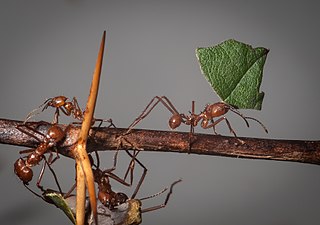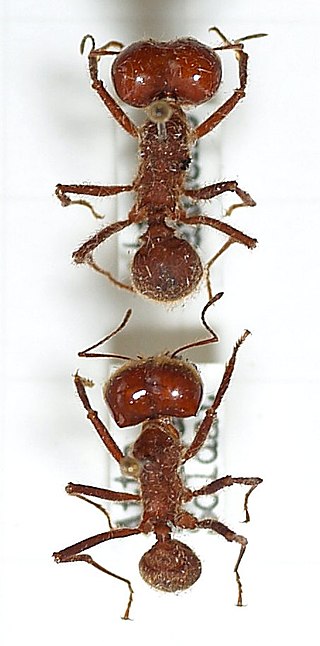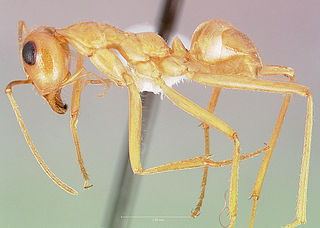
Ants are eusocial insects of the family Formicidae and, along with the related wasps and bees, belong to the order Hymenoptera. Ants evolved from vespoid wasp ancestors in the Cretaceous period. More than 13,800 of an estimated total of 22,000 species have been classified. They are easily identified by their geniculate (elbowed) antennae and the distinctive node-like structure that forms their slender waists.

Atta is a genus of New World ants of the subfamily Myrmicinae. It contains at least 17 known species.

Leafcutter ants are fungus-growing ants that share the behaviour of cutting leaves which they carry back to their nests to farm fungus. Next to humans, leafcutter ants form some of the largest and most complex animal societies on Earth. In a few years, the central mound of their underground nests can grow to more than 30 m (98 ft) across, with smaller radiating mounds extending out to a radius of 80 m (260 ft), taking up 30 to 600 m2 and converted into 3.55 m individuals.

Fungus-growing ants comprise all the known fungus-growing ant species participating in ant–fungus mutualism. They are known for cutting grasses and leaves, carrying them to their colonies' nests, and using them to grow fungus on which they later feed.

The Texas leafcutter ant is a species of fungus-farming ant in the subfamily Myrmicinae. It is found in Texas, Louisiana, and north-eastern Mexico. Other common names include town ant, parasol ant, fungus ant, cut ant, and night ant. It harvests leaves from over 200 plant species, and is considered a major pest of agricultural and ornamental plants, as it can defoliate a citrus tree in less than 24 hours. Every colony has several queens and up to 2 million workers. Nests are built in well-drained, sandy or loamy soil, and may reach a depth of 6 m (20 ft), have 1000 entrance holes, and occupy 420 m2 (4,500 sq ft).

Atta sexdens is a species of leafcutter ant belonging to the tribe Attini, native to America, from the southern United States (Texas) to northern Argentina. They are absent from Chile. They cut leaves to provide a substrate for the fungus farms which are their principal source of food. Their societies are among the most complex found in social insects. A. sexdens is an ecologically important species, but also an agricultural pest. Other Atta species, such as Atta texana, Atta cephalotes and others, have similar behavior and ecology.

Acromyrmex is a genus of New World ants of the subfamily Myrmicinae. This genus is found in South America and parts of Central America, México and the Caribbean Islands, and contains 33 known species. Commonly known as "leafcutter ants" they comprise one of the two genera of advanced attines within the tribe Attini, along with Atta.

Mycocepurus smithii is a species of fungus-growing ant from Latin America. This species is widely distributed geographically and can be found from Mexico in the north to Argentina in the south, as well as on some Caribbean Islands. It lives in a variety of forested habitats and associated open areas. Two studies published in 2009 demonstrated that some populations of the species consist exclusively of females which reproduce via thelytokous parthenogenesis. A detailed study found evidence of sexual reproduction in some populations in the Brazilian Amazon. Accordingly, M. smithii consists of a mosaic of sexually and asexually reproducing populations. In asexual populations all ants in a single colony are female clones of the queen. Inside the colony, the ants cultivate a garden of fungus grown with pieces of dead vegetable matter, dead insects, and insect droppings.

Atta mexicana is a species of leaf-cutter ant, a New World ant of the subfamily Myrmicinae of the genus Atta. This species is from one of the two genera of advanced attines within the tribe Attini.

Acromyrmex heyeri is a species of leaf-cutter ant, a New World ant of the subfamily Myrmicinae of the genus Acromyrmex.

Acromyrmex versicolor is known as the desert leafcutter ant. A. versicolor is found during the summer months in the Colorado and Sonoran deserts when there is precipitation. They form large, distinctive nest craters that are covered with leaf fragments. Living and dead leaves are collected by workers and used to cultivate fungus gardens. Each colony can have multiple queens, if they do this is a practice called polygyny, and each queen has her own batch of “starter” fungus. This species does not sting.

Pogonomyrmex occidentalis, or the western harvester ant, is a species of ant that inhabits the deserts and arid grasslands of the American West at or below 6,300 feet (1,900 m). Like other harvester ants in the genus Pogonomyrmex, it is so called because of its habit of collecting edible seeds and other food items. The specific epithet "occidentalis", meaning "of the west", refers to the fact that it is characteristic of the interior of the Western United States; its mounds of gravel, surrounded by areas denuded of plant life, are a conspicuous feature of rangeland. When numerous, they may cause such loss of grazing plants and seeds, as to constitute both a severe ecological and economic burden. They have a painful and venomous sting.

Formica truncorum is a species of wood ant from the genus Formica. It is distributed across a variety of locations worldwide, including central Europe and Japan. Workers can range from 3.5 to 9.0mm and are uniquely characterized by small hairs covering their entire bodies. Like all other ants, F. truncorum is eusocial and demonstrates many cooperative behaviors that are unique to its order. Colonies are either monogynous, with one queen, or polygynous, with many queens, and these two types of colonies differ in many characteristics.

Myrmecocystus mexicanus is a species of ant in the genus Myrmecocystus, which is one of the six genera that bear the common name "honey ant" or "honeypot ant", due to curious behavior where some of the workers will swell with liquid food until they become immobile and hang from the ceilings of nest chambers, acting as living food storage for the colony. Honey ants are found in North America, Australia, and Africa. Ant species belonging to the genus Myrmecocystus reside in North America. M. mexicanus in particular is found in the southwestern United States and parts of Mexico.

Liometopum apiculatum is a species of ant in the subfamily Dolichoderinae. Liometopum apiculatum ants are found in arid and semi-arid regions of southwestern United States and Mexico to Quintana Roo.

Pogonomyrmex badius, or the Florida harvester ant, is a species of harvester ant in the genus Pogonomyrmex. It is the only Pogonomyrmex species found on the east coast of the United States and the only one in North America known to be polymorphic. The Florida Harvester ant is commonly found in Florida scrub and other similar habitats within the Atlantic coastal plain.
This is a glossary of terms used in the descriptions of ants.

Pleometrosis is a behavior observed in social insects where colony formation is initiated by multiple queens primarily by the same species of insect. This type of behavior has been mainly studied in ants but also occurs in wasps, bees, and termites. This behavior is of significant interest to scientists particularly in ants and termites because nest formation often happens between queens that are unrelated, ruling out the argument of inclusive fitness as the driving force of pleometrosis. Whereas in other species such as wasps and bees co-founding queens are often related. The majority of species that engage in pleometrosis after the initial stages of colony formation will reduce their colonies number of queens down to one dominant queen and either kill or push out the supernumerary queens. However there are some cases where pleometrosis-formed colonies keep multiple queens for longer than the early stages of colony growth. Multiple queens can help to speed a colony through the early stages of colony growth by producing a larger worker ant population faster which helps to out-compete other colonies in colony-dense areas. However forming colonies with multiple queens can also cause intra-colony competition between the queens possibly lowering the likelihood of survival of a queen in a pleometrotic colony.

Novomessor ensifer is a species of ant endemic to Mexico. A member of the genus Novomessor in the subfamily Myrmicinae, it was first described by Swiss entomologist Auguste Forel in 1899. N. ensifer was originally a part of the genus Aphaenogaster until a recent phylogenetic study concluded that Novomessor was genetically distinct and should be separated. The ant is a medium-sized species, measuring 5.5 to 10 millimetres. The ant is ferruginous-colored in some certain parts of the body, and small workers (nanitics) in incipient colonies are noticeably different in color and body structure.

Leucocoprinus gongylophorus is a fungus in the family Agaricaceae which is cultivated by certain leafcutter ants. Like other species of fungi cultivated by ants, L. gongylophorus produces gongylidia, nutrient-rich hyphal swellings upon which the ants feed. Production of mushrooms occurs only once ants abandon the nest. L. gongylophorus is farmed by leaf cutter ant species belonging to the genera Atta and Acromyrmex, amongst others.



















